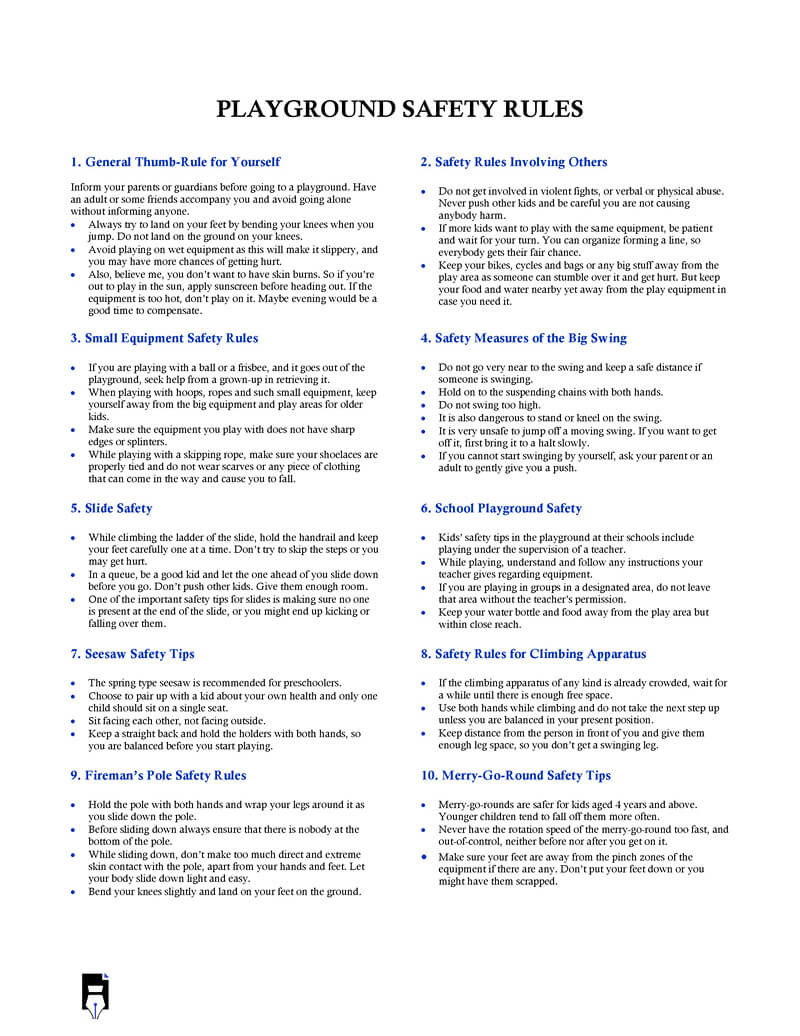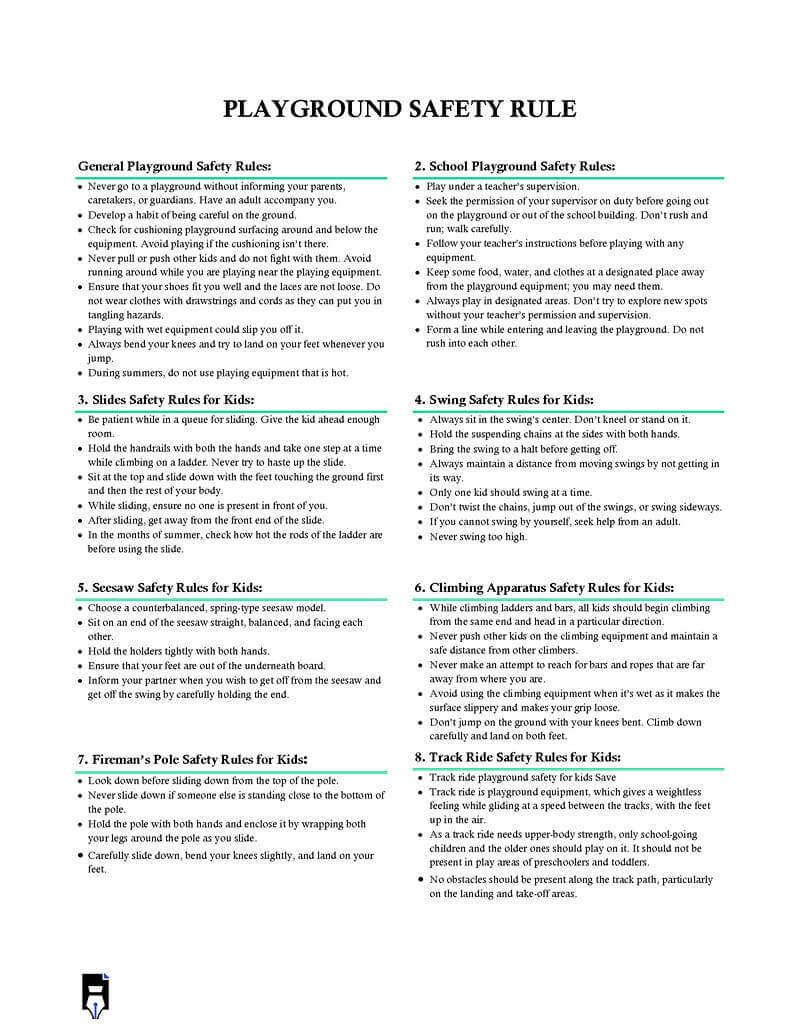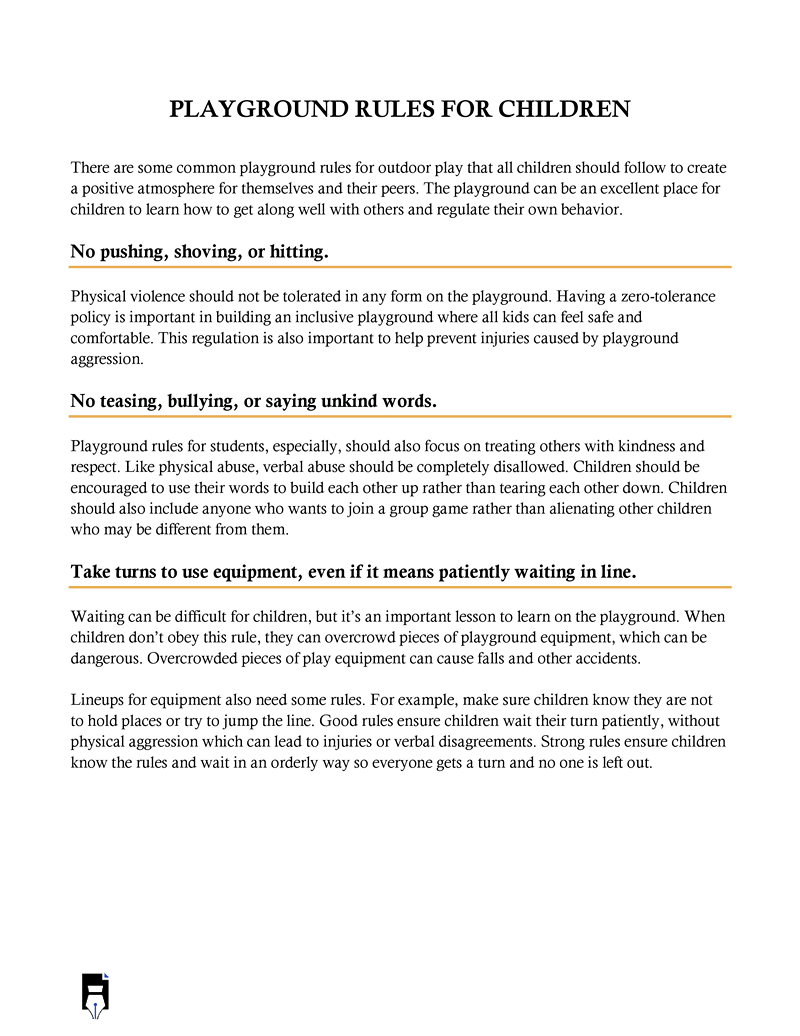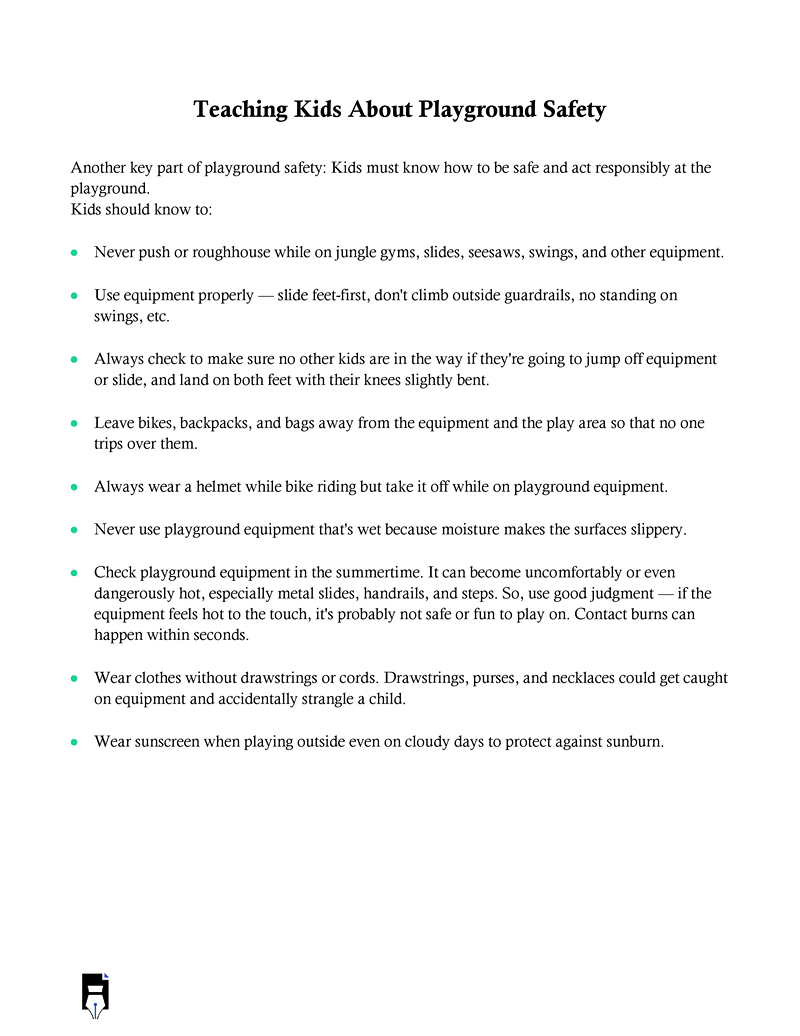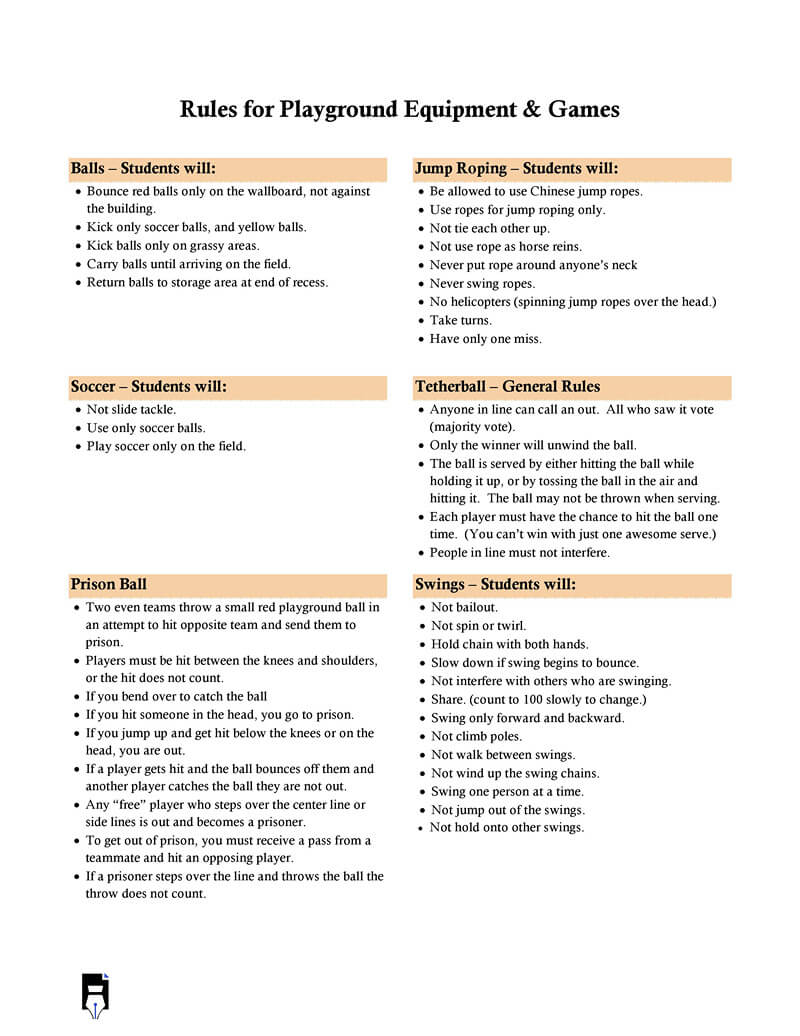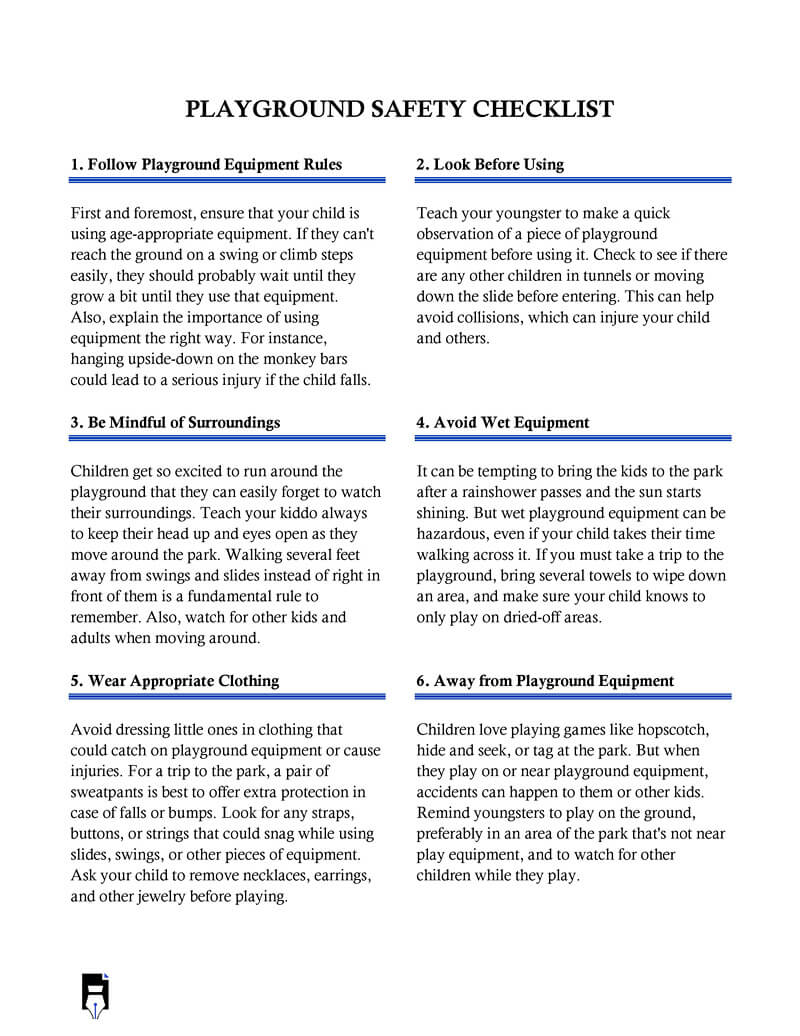Playground injuries are widespread. In the US, more than 200,000 kids visit hospitals every year because of these injuries. While at a playground, kids run, jump, and fall. Minor injuries are all part of having fun and growing up. However, unforeseen circumstances can lead to more harmful and severe injuries.
Since the kids’ safety always comes first, every playground must have a specific set of rules. Therefore, before letting your kid roam the playground freely, you should always read the rules. Therefore, teaching your kid the most basic rules and safety tips is essential.
In this article, you will be able to learn:
- What is playground safety?
- Why are playground rules and guidelines important?
- Factors to consider before playing on school grounds
- Playground behaviors in children
- Playground safety rules and precautions
- Fun facts
What is Playground Safety?
Children often engage in various activities at a playground. Unfortunately, while having fun, they are also vulnerable to some injuries. Minor bumps, bruises, and cuts are the most common.
However, kids can also suffer from other, more playground-related severe injuries such as sprains, strains, dislocations, fractures, and concussions. The most common causes of injuries are falls and slides.
Playground safety is about preventing those injuries or minimizing the risk of kids getting injured at a playground. It encompasses several basic best practices and tips for parents and kids to ensure their safety and a memorable time on the playground.
Why are Playground Rules and Guidelines Important?
Playground rules and guidelines are essential for several reasons, and the best way to understand their importance is to look at the benefits they provide.
Playground rules are important because they communicate safe and appropriate behaviors at a playground. In addition, they ensure that every kid and parent know what to do, whether it is their first time at the playground or not.
Playgrounds and equipment enable kids to have fun, exercise and make new friends. The rules are essential because they facilitate the kids, ensuring that faulty equipment, damaged surfaces, and unwanted behavior do not ruin the fun.
Bullying and wrongdoings are not uncommon on playgrounds. When there are no rules and guidelines, children may feel uncomfortable. The rules also represent what kids should do if they are victims of wrongdoings and bullying. It gives them a voice of authority which helps them feel more confident, comfortable, and relaxed.
Clearly outlined rules can also help keep kids at a playground well-disciplined. For example, if some kid exhibits unwanted behavior or puts other kids at risk of an injury, the rules enable you to remove the kid from the playground. In addition, the rules outline unwanted behaviors at a playground so that no parent or child can say they were unaware that such behavior is prohibited.
Rules are also suitable for the teachers and supervisors present at the playground. The rules ensure they cannot make biased decisions regarding which child to remove from the playground if they break a rule. In addition, since the rules are public, parents can also read them, preventing them from accusing teachers and supervisors of unfair preference.
Factors to Consider before Playing on School Grounds
The best way to ensure your and other children’s safety on school grounds is to consider all the essential factors discussed below:
Follow playground equipment rules
Not all playgrounds are the same regarding play areas and equipment on the premises. In addition, every play area and equipment has its own set of rules. The most important thing you should do is to ensure your child only plays using age-appropriate equipment in the play areas. You should also ensure your child always uses the equipment correctly.
Be conscious of your surroundings
Moving around the playground while avoiding harm is essential. Playground gets kids excited, and they can quickly lose focus and stop paying attention to their surroundings. So, teaching your kid to be conscious of their surroundings is essential. Keeping a safe distance from slides and swings is the most important thing you can teach your little one.
Avoid wet equipment
Wet playground equipment can be hazardous. Water makes equipment slippery, and kids can easily fall. Playing in wet clothes can also increase the risk of catching a cold. If you plan on going to a playground after the rain, do yourself a favor and bring some towels to wipe down wet areas. It would be best to teach your kid that only dry areas are suitable for play.
Wear proper clothing
Children’s clothing is also one of the common causes of playground injuries. Clothing can get stuck into equipment which can lead to an injury. Avoid clothes with strings, buttons, and strips, as they can get stuck in the equipment. The same applies to jewelry, especially necklaces. Instead, your kid should wear something as simple as a sweatsuit.
Look before using an equipment
One of the best practices is to quickly inspect the playground equipment before allowing your kid to play. It especially goes for slides and tunnels. Teach your child to inspect the equipment before using it. Your kid should also wait for others to be at a safe distance from the slide or tunnel before using it. It would be best to inspect the equipment to observe any breakages and malfunctions to ensure the safety of your and other kids at the playground.
Do you know? You can leverage playground rules to promote positive behaviors in kids at a playground. When creating the rules for your playground, you can formulate them so that kids can easily understand why certain behaviors can help protect them and their friends.
Playground Behaviors in Children
Kids at a young age most commonly learn behaviors by observing and modeling the conduct of a person they perceive as a role model. For example, a role model at a playground can be a teacher, parent, or supervisor.
As role models, caregivers can promote positive behaviors in kids if they exhibit them at a playground. However, they should also know which behavior should be encouraged and discouraged in a child.
Behaviors that should be encouraged
It would be best to encourage the following behaviors in kids while at the playground as they promote positive behaviors:
- Conflict resolution: Children can often disagree with the concept of playing together, sharing, and taking turns. It can lead to conflict, bullying, and exclusion. A playground is a place where kids get in contact with their peer group and learn social skills. You should encourage verbal conflict resolution to teach the kids an essential skill they will keep using in the future.
- Communication: Efficient communication is a skill that can benefit kids both on and off the playground. It is crucial for healthy child development and can encourage inclusivity, helping your kid feel welcome and safe at the playground.
- Collaboration: Kids can use play areas and equipment at a playground in many ways. However, it would be best to encourage collaboration. Collaboration can help turn game time into a team activity and encourage kids to make new friends and improve their communication skills.
- Personal space: Personal space and sharing are linked together. Unfortunately, it is one of the most challenging concepts for kids to understand. Kids should feel comfortable playing, and you can help them by creating rules that encourage personal space.
- Sharing: Unlike their toys at home, a playground is where all kids have to share. They share everything, including equipment and play areas. You can make sharing easy to understand with simple rules such as no pushing and no skipping the queue.
Behaviors that should be discouraged
You should keep an eye on the following behaviors and discourage them with relevant rules:
- Teasing and name-calling: While most playground rules prevent physical injuries, you should never forget emotional ones. Words can hurt little ones as well and make them feel less confident. In addition, name-calling and teasing can escalate into more harmful behaviors.
- Roughhousing: It’s paramount to discourage roughhousing at a playground. Behaviors similar to pushing and shoving can encourage aggressive behavior. They can also cause the kids to fall and get injured. Therefore, there should be rules that prevent roughhousing of any sort.
- Exclusion: Exclusion is not something that you want to have on a playground. It creates a negative dynamic. Additionally, kids that are excluded are more vulnerable to bullying. You can discourage such behavior with rules that encourage teamwork, collaboration, and communication.
Playground Safety Rules
Below you can find examples of playground safety rules addressing specific risks and ensuring safety for all kids at the playground:
Rules for children
- Don’t go alone to a playground. Have an adult, either parent or guardian, accompany you.
- Use the equipment properly. Don’t stand on swings, feet-first when sliding, and only use guardrails to climb on the equipment.
- Don’t use playground equipment if it is wet; wet equipment is slippery.
- Don’t wear jewelry and clothing with cords and drawstrings – it can get caught on the equipment.
- Apply sunscreen during summer, even if it’s not sunny, to avoid painful skin burns.
Rules involving others
- Leave bags, backpacks, and bikes away from the equipment and play areas. You or other kids can trip over them and get hurt.
- Contact your parents or guardians if an adult stranger approaches you and starts to talk to you.
- Wait for your turn if there are kids that want to play with the same equipment you want. Then, you can start a queue so that everyone gets their turn to have fun.
- Don’t push or roughhouse any kids. Instead, stay out of fights and avoid physical and verbal abuse.
- Ensure no other kid is on the equipment before using a tunnel.
Small equipment safety rules
- Don’t pursue the ball or frisbee if they depart the playground. Instead, talk to a grown-up and ask for help.
- Before using the playground equipment, ensure it doesn’t have splinters or sharp edges.
- Don’t play with ropes, hopes, or other small equipment near the extensive equipment and busy play areas.
- Always make sure your shoelaces are adequately tied and remove the scarf when playing with skip rope.
- If you bring your equipment to a playground, inspect it for signs of wear and tear before using it or sharing it with other kids.
Big swing safety measures
- Don’t stand and kneel on the swing or jump from it.
- While you may find it exciting, don’t swing too high.
- Keep both your hands on suspending chains at all times.
- Keep a safe distance from the swing while someone is swinging.
- Ask your guardian or parent for assistance if you can’t swing yourself.
Slide safety
- Inspect a slide before using it during summer. It can be too hot and burn you if you use it.
- Don’t skip steps when you are climbing the slide.
- Always hold the handrail when climbing the slide and bring your feet one at a time.
- Make sure no one is present on the slide before using it.
- After you use the slide, stand at some distance so other kids can use it.
Seesaw safety rules
- Don’t climb on the moving seesaw and onto the middle of it.
- When sitting on the seesaw, make sure you are not facing outside but each other.
- Only one kid should be on a single seat.
- While on the seesaw, keep your feet away from underneath your seat.
- Keep your hands on the holders and straight back. It gives you more balance.
Safety rules for climbing apparatus
- Only reach for ropes and bars that are close to you. Outreaching can cause you to lose your grip and fall.
- If someone is in front of you on a climbing apparatus, keep a safe distance and give them enough leg space.
- If the climbing apparatus is too crowded, wait until there is enough space for you to climb safely.
- Make your way down slowly, ensuring you don’t hit others.
- Only reach for the next rope or bar if you are well-balanced in your current position.
Fireman’s pole safety rules
- Make sure no one is at the bottom of the pole before you start using it.
- Keep your legs warped around the pole with both hands on it when using it.
- Don’t move too fast. Instead, do it slowly to avoid skin burns.
- Don’t hold the pole too tight. Too much extreme contact can cause injuries.
- Before lying on the ground, bend your knees slightly to avoid hurting your ankles or knees.
Merry-go-round safety tips
- It is safe to use the merry-go-round if you are four years or older. However, younger kids are known to fall from them frequently.
- While on the merry-go-round, make sure to keep holding the bars tightly.
- Don’t spin the merry-go-round too fast – it can make you dizzy, or someone can fall from it.
- Don’t move your feet out of the pinch zones to avoid injuring them.
- If you feel dizzy, ask someone to stop the merry-go-round, wait for the dizziness to spot before dismounting, and ask a guardian or parent for assistance.
Playground Rules Free Templates
You can download the following templates of playground rules for free:
Playground Safety Precautions
As a parent, guardian, or teacher, you play an essential role in ensuring the safety of the kids or school students at a playground.
Here are the most important safety precautions you should practice:
Before the play begins
Before the kids play, you should ensure the kids understand the basic playground rules before the kids play. Invest time and effort in explaining why they are essential and the potential consequences of not following the rules.
Before letting the kids explore the playground and have fun, you need to ensure that there are no potential playground hazards. Look for risky surfaces and rusted or broken equipment. If you identify potential hazards, you should report them to authorities maintaining the playground.
You should dress your kids appropriately before they use the equipment and play areas. Take off any clothing with drawstrings, cords, purses, scarves, and necklaces. It would be best to put bike helmets aside too.
Supervise the play area
While the kids are having fun at a playground, you should keep an eye on them, especially if they jump, run, or start racing. Paying attention will enable you to react quickly if you spot pushing and roughhousing so that you can prevent it from escalating.
You should also pay attention that kids are following the specific rules that apply to using certain equipment and play areas so that you can intervene if you see that someone is at risk of getting injured.
Choose an appropriate area for kids
The thumb rule is to ensure that younger kids and toddlers should play in their area while older children should have their section. This is because the older children use more significant equipment and tend to jump and run a lot, which can expose toddlers to risks of injury.
Every equipment and play area at a playground has a recommended age for kids. You need to ensure that spaces for toddlers and younger kids have the appropriate equipment and do the same for areas designed for older kids to play.
If your toddler is making his/her first steps, you should play in areas with a safe surface. These surfaces are even, smooth and free of faults. In addition, the child should be able to walk, run, and jump before being put in a baby swing.
Opt for safe surfaces
The surface at the playground plays a vital role in preventing injuries. It would be best to choose safe surfaces. Don’t allow kids to play on non-impact absorbing surfaces such as concrete or asphalt.
Impact absorbing surfaces include wood chips, sand, pea gravel, mulch, and shredded rubber. The safest surfaces are synthetic turf and rubber mats. They need to be at least 12 inches thick with a surface of 6 by 6 feet.
The size of the surface depends on the equipment at the playground. Some equipment requires larger surfaces – such is the case with swings, which require a surface at least twice the height of the suspending bars.
Important Facts to Know about Playground Safety
- Improper supervision stands as the primary reason for 45% of playground injuries.
- Kids aged 5–9 have the highest rate of injuries.
- Hospitals treat more than 200,000 kids every year for playground-related injuries.
- Girls are less frequently injured than boys.
- Most playground-related injuries occur on swings, monkey bars, and climbing apparatus.
- 70% of playground-related deaths take place at home playgrounds.
- Almost 60% of playground injuries include abrasions and fractures, while the highest rate of traumatic brain injuries is found in four-year-old kids.
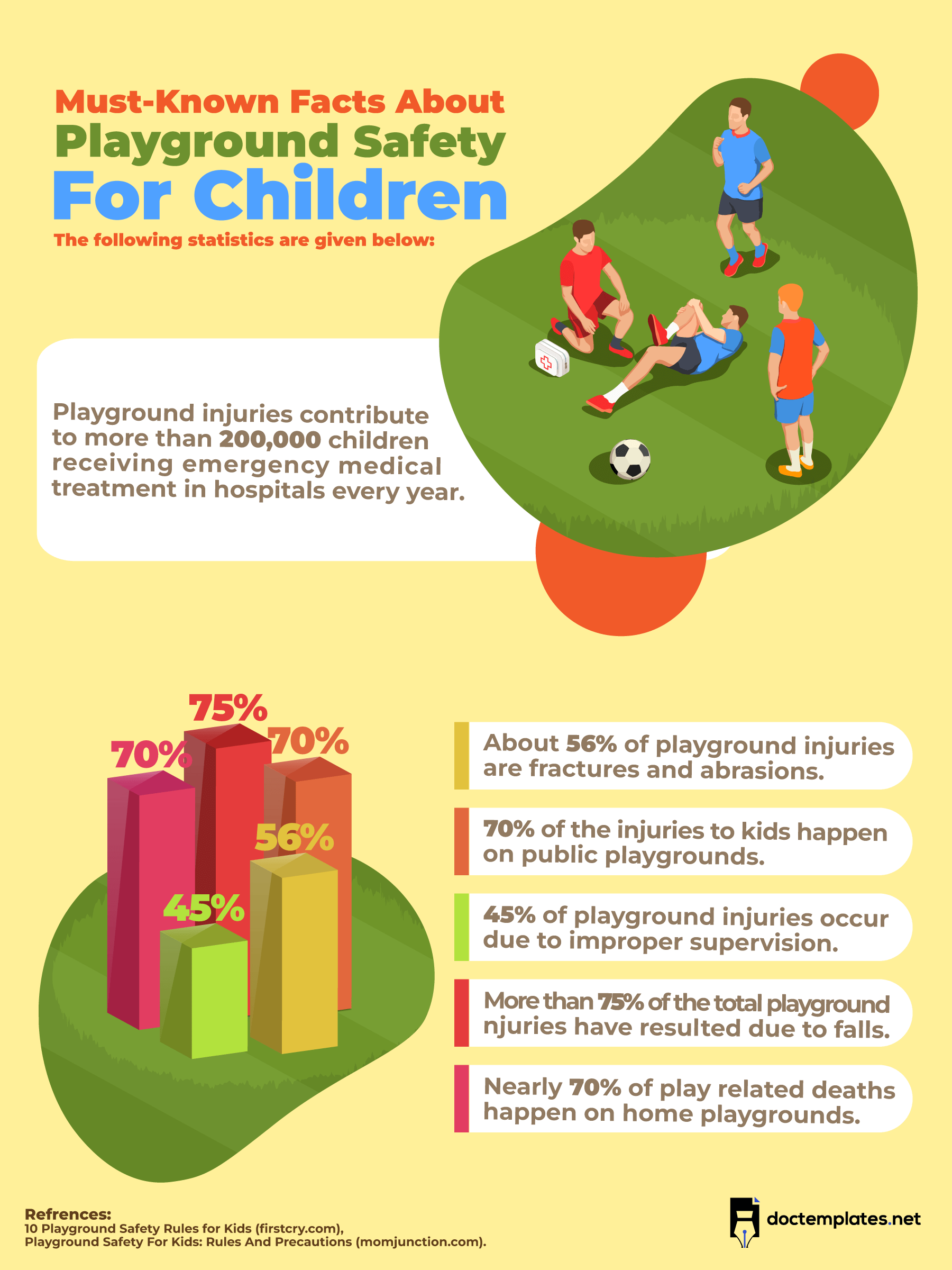
Summary
While playgrounds are designed for kids to exercise, have fun, and socialize, you must set a few basic safety rules. Playground safety rules and tips minimize the risk of injuries and make kids feel safe and welcome at playgrounds.
They can also help discourage bullying, exclusion, and name-calling, thus making a playground a safe place for kids of all ages. The above-mentioned playground safety rules and precautions will help you keep children at your school playground safe.
